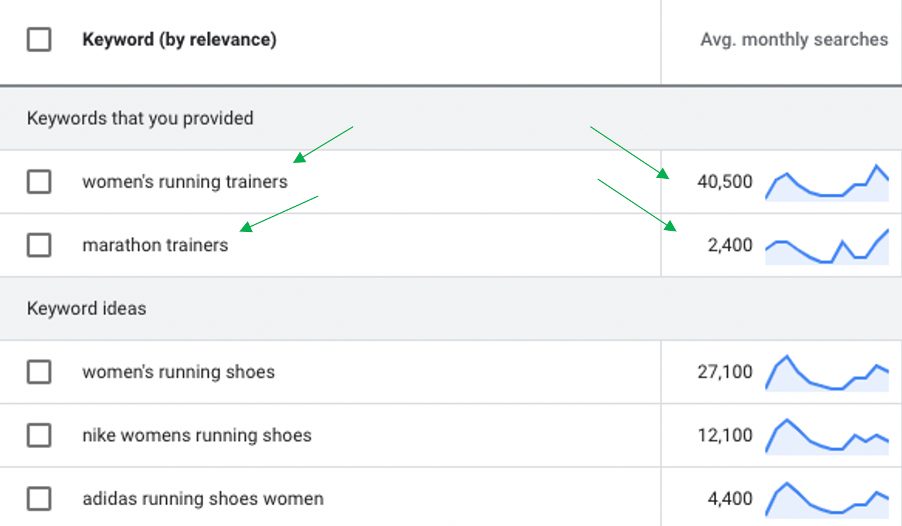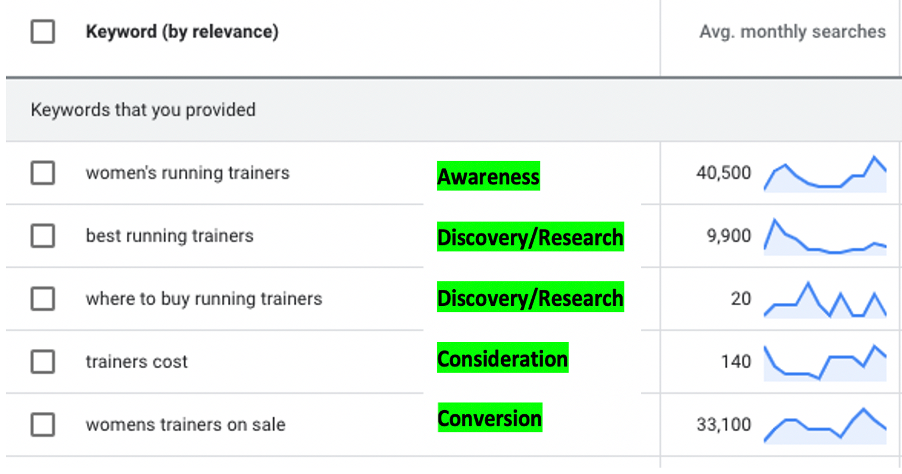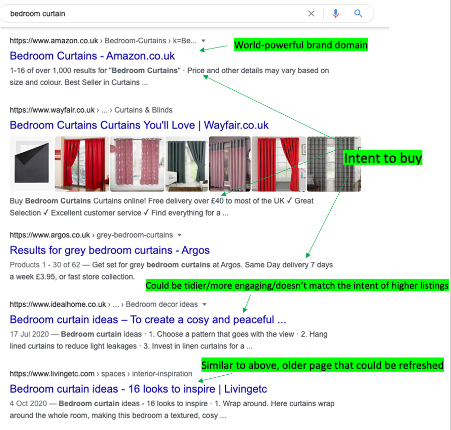How To Choose Keywords in SEO
You’ve probably heard that keywords are super important if you want to succeed in SEO.
If you rank for a keyword (and it gets clickthroughs), you’ll get organic website traffic.
So how do you know how to choose keywords in SEO?
We’ll take things back to basics, so you can understand what’s involved in choosing keywords because there’s a lot to it.
- Begin with keyword research
- Identify the search intent
- See which stage of the buyer journey the person is at
- Look at your online competition
- Ask yourself which form of content is best
- Write a keyword map
Begin with keyword research
What is a keyword? A keyword is a term that’s been searched by a number of people.
It’s measured on an average and monthly basis.
For example, “women’s running trainers” has an average of 40,500 searches a month.
You can see similar searches in the below example using Google Keyword Planner.

Why is keyword research important?
Keyword research allows you to understand exactly what people are looking for when they search a term.
It’s crucial that you understand this if you are to create a page or optimise a page to target your keyword.
You can learn more about what keyword research is in our blog in much more detail.
And find out what keyword cannibalisation is, why it’s bad for SEO and how to fix it.
But for the here and now, we’ll touch on how to identify search intent and ensure you create the right type of content to target your audience.
Identify the search intent
There are typically three different types of search intent.
We’ve covered the ins and outs of this in our guide to keyword research.
But the types are:
- Transactional
- Informational
- Navigational
| Search intent | What are they looking for? | Keyword example |
|---|---|---|
| Transactional | They are ready to buy | Women’s shoes for sale |
| Informational | They want information, they’re not at buying stage yet | Best women’s shoes 2020 |
| Navigational | They’re looking for something in particular, like a local store | Where can I buy women’s shoes |
When you’re doing your keyword research, keep this thought at the centre of the process.
Whatever keyword research you’re doing, the page you’re working on will always have a specific purpose, or intent.
Here is a list of the different types of pages that will all need effective keyword research for.
- product
- category/sub category
- FAQ
- home
- landing for PPC/SEO campaigns, eBook downloads
- creative blog content
See which stage of the buyer journey the person is at
What’s the buyer journey? It’s another way of referring to the digital marketing funnel.
We’ve explained what it is, and how businesses can, and should, use the digital marketing funnel to drive more leads or sales.
But in case you’re tight on time, here’s a summary.
Summary of the buyer journey
The buyer journey typically falls into 5 different phases, like this:
- Awareness – when someone realises they have a problem and need a solution
- Discovery/Research – when someone starts to dig around for the best, most effective solution
- Consideration – when someone is interested in a purchase and is seriously weighing up becoming a customer
- Conversion – when someone takes the leap and buys from you
- Post-conversion loyalty – when someone becomes a brand ambassador by giving positive reviews, and maybe buying from you again
When you’re doing keyword research, you’ll likely find that there are hundreds of keyword opportunities to find, choose from and narrow down.
You need to get the keyword intent right, and then match the keyword to the respective funnel stage for that piece of content.
So, how do you action this when you’re looking at all of the hundreds of keywords?
Here’s an example to help you start to see how it all matches up, with some keyword research from Keyword Planner.

Look at your online competition
Never assume you already know who your competition is.
Often your offline competition can be different to what’s really happening in the SERPs.
Use a SERP analysis tool, or manually search for the keyword you have in mind.
Here are some pointers to look out for to decide how competitive that keyword is.
Look at the domain authority (DA) of your page 1 competitors.
You can do this using an SEO analysis tool.
Then, if you spot straight away that all of the top listings have a DA of 90+ and yours is significantly lower than that, it’s worth parking that idea for now.
Or, you might find that the reality is some of the page 1 listings don’t have many backlinks, and it could be an opportunity to target.
Look at the type of websites that rank.
Is it heavily widely recognised brands, or a mix of lesser known sites too?
If it’s the former, your efforts might be best placed elsewhere.
Look at the actual content in the SERPs.
Can you create meta data that’s even more engaging and targets the user’s search intent even more effectively?
Could you add schema or create a click-bait title to outrank one of those listings?
Look at what your ranking competitor ranks for, for that page.
Drop that URL into a keyword tool to find out what other keywords it ranks for.
You might find that it’s a) recently updated (which is why Google likes it) and means you could re-vamp your content into even more valuable copy and aim to outrank them.
Or, b) it has maintained the top position for months and is too competitive.
Once you’ve got your big set of keywords, and you then work through your online competitors, you should start to really narrow down on which keywords are genuinely realistic, but good opportunities with reasonable search volume.
Here is an example, for the keyword ‘bedroom curtain’.

Ask yourself which form of content is best
Now you need to think right back to that keyword intent. It won’t work to just pick one of those keywords and ‘do a blog on it’.
Why, we hear you ask? Because people would much rather digest something visually pleasing, than huge blocks of boring text. In fact, research says in 15 minutes, two thirds of people prefer to “read something beautifully designed than something plain”.
In fact, with 43% of people admitting they skim read blogs, you’re seriously missing a trick if you’re stuck with ‘inside the box’ thinking.
How do you get outside the box then? You give your reader what they’re looking for. Ask yourself:
- Who will be searching that term?
- What information do they want?
- So, which form is going to be the easiest to digest it in?
For example, let’s say your ideal customer is a middle aged manager, who’s in a rush and needs solutions to take to his team and his own manager.
Here are some recommendations to make his life easier, and give him what he wants as quickly as possible.
- Easily shareable, demonstrative product video on a product page
- Quickly downloadable information-packed eBook
- Visual infographic on the benefits of using the product
Write a keyword map
The last job, before actually writing for SEO and optimising your content, is to create a keyword map.
Make a list of all of your pages you want to optimise.
We recommend doing this in a clean Excel document. Assign your newly decided keyword to each of the pages, and note down the search volume next to it.
We also recommend going one step further, and marking each keyword’s level of relevance.
This way, you’ll clearly pinpoint which is your most important primary keyword, and then which others (secondary and tertiary) are more of supporting indicators to Google.
If you do this for creative content as well as optimising the rest of your website, you could create a whole content calendar.
This is a good idea if you can consistently produce regular, quality content to your website. Google likes frequent uploads of valuable copy, and can rank you better for it.
You’re ready to optimise and create content.
If you’ve like some help, we’ve got plenty of resources available, including:
Follow on Instagram, Twitter, Facebook and LinkedIn while you’re here, to stay updated on all the latest content.